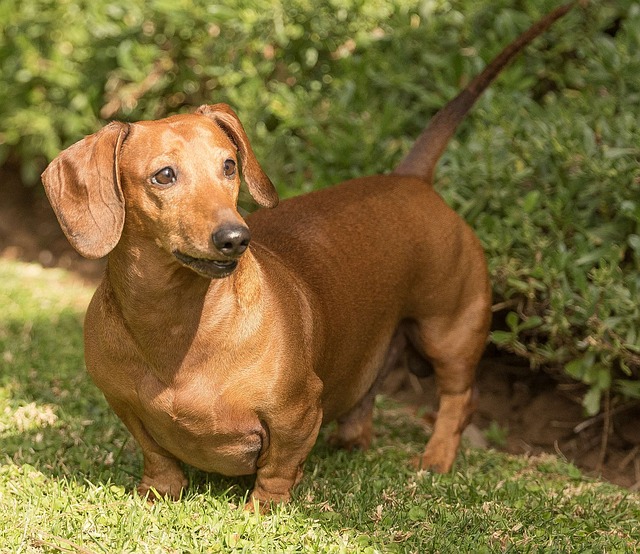The Dachshund breed possesses many characteristics despite its small size. People refer to it as a wiener dog due to its distinctive features. These hunt-trained dogs with affectionate nature bring joy to every owner they meet including members of big and small households. Our guide explains every aspect of the Dachshund lifestyle with details about its past and current features plus how to train feed exercise and maintain the dog.
Table of Contents
- Introduction to Dachshunds
- History and Origin
- Physical Characteristics
- Personality and Temperament
- Training a Dachshund
- Exercise and Activity Needs
- Nutritional Requirements and Diet
- Grooming and Hygiene
- Common Health Issues and Preventive Care
- Socialization and Behavior
- Living Conditions and Adaptability
- Fun Activities and Games
- Conclusion
1. Introduction to Dachshunds
The Dachshund breed has its tiny size but shows strong hound traits in personality. This dog breed stands apart from others because of their special shape and endless energy. They win hearts in homes all over the world through their pleasant and self-reliant personality.
2. History and Origin
The first Dachshunds appeared in Germany more than 600 years ago. Their breeders developed them as hunting dogs for digging out badgers and other animals that hide in burrows. The term Dachshund comes from its original purpose as a hunter of badgers.
Fun Fact:
A Dachshund exists as a smooth-haired type plus two other variants: wire-haired and long-haired.
3. Physical Characteristics
Size and Build
Height: 8-9 inches (standard), 5-6 inches (miniature)
Weight: 16-32 pounds (standard), under 11 pounds (miniature)
Build: Long body, short legs, muscular frame
Coat and Colors
Dachshunds display numerous coats such as red, black and tan, chocolate and tan, dapple, and cream.
Red
Black and Tan
Chocolate and Tan
Dapple (spotted patterns)
Cream
4. Personality and Temperament
The brave personality of Dachshunds combines with their naturally independent qualities.
Are Dachshunds Suitable for Families?
Yes! Children thrive in a family environment because this breed shows perfect compatibility with loving loving-hearted nature.
Are Dachshunds Good Guard Dogs?
Yes! Small in stature Dachshunds function as effective watchdogs at the same time they make loud warning noises due to their high energy levels.
5. Training a Dachshund
Despite their smartness, Dachshunds need repetitive instruction to learn since they resist lessons.
Basic Training Tips:
Begin training your Dachshund puppies right from the start.
Give them treats plus verbal praise as rewards.
They learn better in brief periods because they focus for minimal times.
It takes perseverance but Dachshunds would reach their training goals with steady repetition.
6. Exercise and Activity Needs
A Dachshund needs regular physical activity to stay in good health because these dogs burn energy quickly.
Daily Exercise Needs:
30-45 minutes of exercise daily
They require walks and games both inside and outside the house.
To protect their backbones they need limited jumping activities
Dachshunds enjoy digging as their nature so create protected digging spots.
7. Nutritional Requirements and Diet
Dachshunds need proper nutrition for full-body wellness.
Recommended Diet:
dachshunds require their dietary needs fulfilled by high-quality proteins which can be obtained from chicken beef turkey and fish.
Healthy fats (omega-3 and omega-6 for coat health)
Carbohydrates (brown rice, sweet potatoes, vegetables)
Feeding Schedule:
- Puppies: 3-4 meals per day
- Adults: 2 meals per day
Since Dachshunds often become obese owners should limit their food intake.
8. Grooming and Hygiene
The grooming schedule of Dachshunds depends on their coat variations.
Grooming Routine:
- Brushing:
- Smooth coat: Once a week
- Long-haired: 3-4 times a week
- Wire-haired: Weekly with occasional trimming
- Bathing: Every 4-6 weeks
- Ear Cleaning: Weekly to prevent infections
- Nail Trimming: Every 2-3 weeks
- Dental Care: Brush teeth 2-3 times per week
9. Common Health Issues and Preventive Care
Dachshunds possess a predisposition to spinal health problems that become more common due to their elongated spinal structure.
Common Health Issues:
- Intervertebral Disc Disease (IVDD) (spinal issues)
- Obesity
- Hip Dysplasia
- Diabetes
- Ear Infections
Preventive Care:
- Regular Vet Check-ups
- Healthy Diet and Exercise
- Avoid Excessive Jumping
10. Socialization and Behavior
Socializing Your Dachshund:
Take your Dachshund to meet multiple strangers plus other animals and environments during the beginning phase.
Support good actions by praising the dachshund.
Common Behavioral Issues:
When left by themselves they develop intense anxiety.
Establish an approved spot for your Dog to dig.
Begin teaching them at a young age to stop barking past reason.
11. Living Conditions and Adaptability

Best Living Conditions for Dachshunds:
- Apartments: Suitable for daily exercise.
- Houses with Yards: They enjoy outdoor play.
- Hot Climates: Provide shade and hydration.
- Cold Climates: Dachshunds need warm clothing in winter.
12. Fun Activities and Games
Dachshunds love interactive play and mental challenges.
Fun Activities:
- Hide and Seek: Engages their hunting instincts.
- Scent Tracking Games: Uses their strong nose.
- Tug-of-War: Encourages bonding and play.
- Agility Training: Strengthens their coordination.
13. Conclusion
Dachshunds display strong devotion with clear minds plus endearing traits. These pets depend on correct treatment plans to exist in content and healthy life.
Key Takeaways:
Energetic and requires daily exercise. Affectionate and great for families. A proper diet balance stops obesity from developing. The dog needs professional grooming and medical attention. Through proper care, the Dachshund stays a loyal and happy friend for several years.




